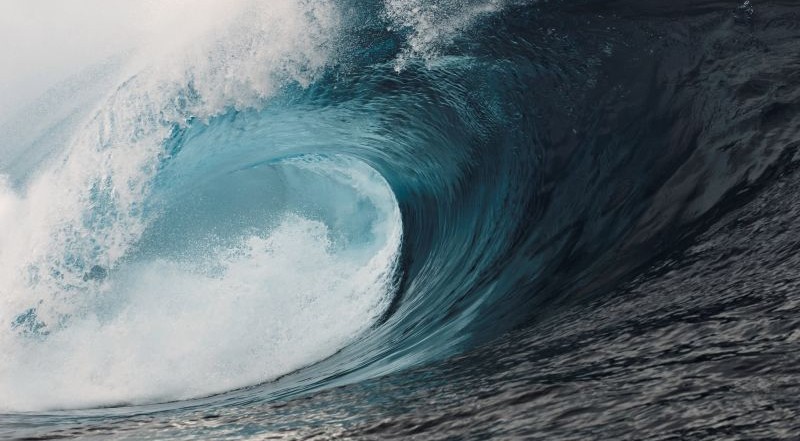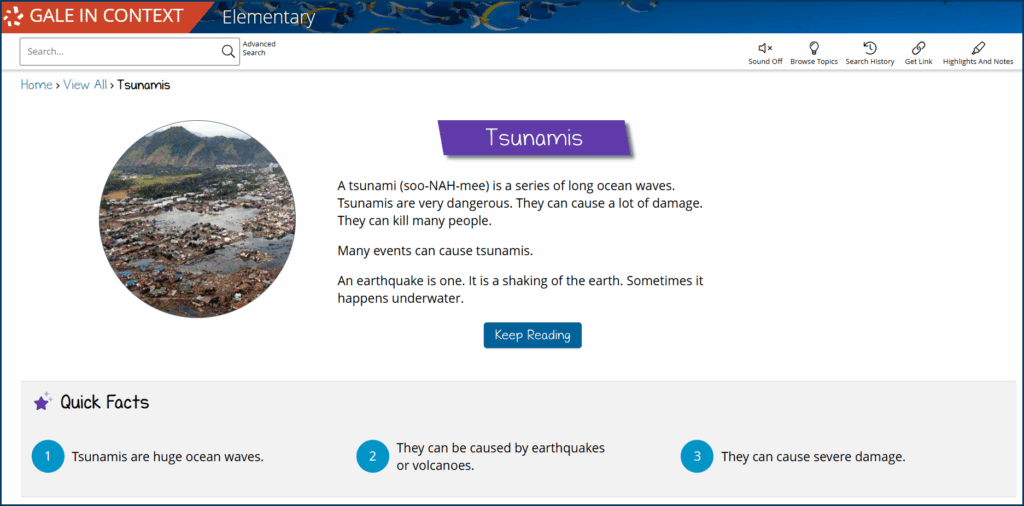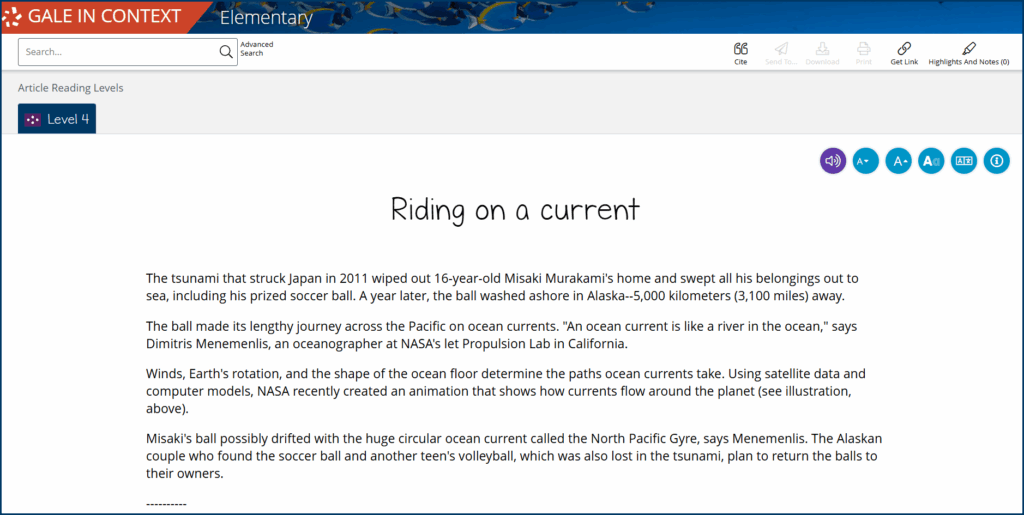| By Gale Staff |
Imagine receiving an alert on your phone that an earthquake has occurred hundreds of miles away from your home—so far, that you couldn’t feel it yourself, but now a tsunami may be heading toward your town. How would you respond? What immediate steps would you take to reach safety?
World Tsunami Awareness Day, observed annually on November 5, provides an opportunity to discuss the science of tsunamis and practical preparedness. Gale In Context: Elementary can support with science-grounded, expert-vetted content to spark young learners’ curiosity with age-appropriate information.
To get started, head over to the tsunami topic page, which provides an overview of this powerful natural phenomenon. And when your students are ready, a wealth of linked materials can open further learning opportunities, through reference entries, diagrams, magazine articles, news stories, and more.
Join us as we examine the science behind tsunamis—what causes them, their potential impact, where they occur—and the alert systems and emergency response plans communities have in place to prepare for them.
The Science Behind a Tsunami
The term tsunami originates from the Japanese words tsu, meaning harbor, and nami, which translates as wave. A tsunami is a series of waves that stem from an earthquake or other disturbance in or near the ocean, causing a disruption and, subsequently, massive waves that strike a coastline in quick succession.
During a tsunami, one wave will reach land and cause a flood, after which it will recede into the ocean, typically exposing the ocean floor. Within minutes, the next wave will flood the shore, often bringing debris caused by the previous onslaught.
What makes tsunamis potentially dangerous is that, as they hit land, the waves occur closer together and get taller—sometimes over 100 feet—until the energy fueling them runs out. Using Gale In Context: Elementary, you can display a diagram with the distinct components of a tsunami and the progression of the waves as they reach the shore.
Understand What Causes Tsunamis
Any significant disturbance, such as an earthquake beneath the ocean or a large landslide near the coast, can trigger a tsunami. Let’s take a look at some of the most common causes—and one that scientists think might have even wiped out the dinosaurs millions of years ago.
Earthquakes
An earthquake happens when tectonic plates, large sections of the Earth’s crust and upper mantle, shift. An earthquake that occurs on the ocean floor can push water up, causing waves that can develop into a tsunami.
For an earthquake to cause a tsunami, it must:
- Occur beneath an ocean or close enough to cause a landslide (see below)
- Take place less than 70 km below the Earth’s surface
- Cause vertical movement in the ocean floor
- Register at least 6.5 on the Richter scale
Landslides
If it dislodges enough debris, a landslide is another potential trigger for a tsunami. The capability of a landslide to cause a tsunami depends on the amount of material that’s displaced, how far it falls, and how quickly it moves.
One such landslide-based tsunami occurred on July 10, 1958, in southeast Alaska. A magnitude 7.8 earthquake triggered a landslide of 40 million cubic yards of rock. This chain reaction led to the largest tsunami in recorded history, with the waves reaching an astounding 1,700 feet in height. Thankfully, the Lituya Bay area is sparsely populated and minimal casualties were reported.
Another such event occurred in Greenland on September 16, 2023, when a melting glacier triggered the collapse of a mountain peak, resulting in a landslide that dumped more than 32 million cubic yards of rock into the Dickson Fjord. The subsequent tsunami triggered by the landslide created waves almost two football fields high.
Volcanic Eruptions
Eruptions from volcanoes can trigger powerful tsunamis. One of the most destructive tsunamis on record happened on August 26, 1883, after the explosion and collapse of Krakatoa, a volcano in Indonesia. The eruption generated tsunamic waves as tall as 135 feet, destroying towns and killing more than 36,000 people on the islands of Sumatra and Java.
Asteroids and Cosmic Impacts
Extraterrestrial objects like meteors can crash into an ocean or hit close enough to displace water and trigger a tsunami. However, extraterrestrial collisions with Earth are extremely rare, and no such incidents have been recorded in modern history.
One such event occurred about 65 million years ago. According to one popular theory, an asteroid struck the coast of present-day Mexico, triggering a tsunami and a chain of destructive events that led to the extinction of the dinosaurs. Scientists at the University of Texas theorize that a massive tsunami from the asteroid consisted of waves reaching heights of almost three miles. Although the tsunami itself didn’t directly cause the extinction of the dinosaurs, it drowned many coastal species and battered landscapes.
Learn Where Tsunamis Typically Occur and Their Impacts
According to the United States Geological Survey, tsunamis can hit any U.S. coast. However, they are more likely to occur in Pacific states and territories like Alaska, American Samoa, Hawaii, and the West Coast, as well as Caribbean regions like Puerto Rico and the Virgin Islands. Anyone living on or near a coast should check with their local government, police, or fire department to see if their area is classified as a tsunami hazard zone.
While no major tsunamis have struck populated regions of the United States in recent years, significant tsunamis have occurred in other parts of the world. Let’s take a look at two of them to better understand their impact.
Indian Ocean Tsunami, Indonesia, 2004
The December 26, 2004, Indian Ocean tsunami was the deadliest tsunami in recorded history. An underwater earthquake with a magnitude of 9.1 to 9.3 on the Richter Scale, equal to about 23,000 Hiroshima-type atomic bombs, triggered waves of up to 100 feet.
The tsunami struck off the coast of Sumatra, Indonesia, but impacted other countries, including Sri Lanka, India, Thailand, and as far away as the coast of East Africa. Approximately 230,000 people lost their lives, and millions were displaced.
Many experts saw this tsunami as a wake-up call for the world to better understand the risks of such events and to develop stronger response and risk management plans. The crisis led to the establishment of the first-ever international tsunami alert systems in the Indian Ocean and beyond.
The Tsunami of Honshu, Japan, 2011
On March 11, 2011, a magnitude 9.0 earthquake triggered a tsunami off the coast of Honshu, Japan. The waves caused extensive damage to coastal towns, washing away homes and destroying local infrastructure. More than 15,000 people lost their lives, and 300,000 were displaced. Despite the loss of life and numerous injuries, Japan’s advanced alert systems, regular community drills, and emergency response plans prevented further casualties.
The disaster at the Fukushima Daiichi Nuclear Power Plant made the 2011 tsunami in Japan especially notorious. When the waves struck the facilities, seawater caused the cooling pumps to fail. As a result, the excessive heating of the nuclear reactors led to several explosions and meltdowns in three reactors. The nuclear disaster prompted the evacuation of more than 100,000 residents.
Debris from the damage of the 2011 tsunami traveled thousands of miles, even reaching the other side of the Pacific Ocean. For instance, a soccer ball belonging to 16-year-old Misaki Murakami washed up on the Alaskan shore, roughly 3,100 miles away.
Reflect on Community Preparedness for World Tsunami Awareness Day
To honor the lives lost and those affected by tsunamis, the United Nations has designated November 5 as World Tsunami Awareness Day. The purpose of this annual observance is to:
- Promote education, particularly about the warning signs of an approaching tsunami
- Encourage disaster preparedness, risk assessment, and impact mitigation
In the spirit of this annual observance, let’s explore the role of tsunami alerts and cover the warning signs. We also discuss the importance of effective communication, thorough preparation, and well-defined evacuation plans.
Learn About Tsunami Alerts, Warning Signs, and Evacuation Plans
An official tsunami alert can come through local emergency alert systems, including mobile devices, radio, or television. To remain safe, it’s a good idea to understand how you should expect to receive alerts in your community.
Different types of alerts represent various levels of threat:
- Tsunami Information Statement: An earthquake has occurred, but it presents no current threat. Residents should continue to watch for updates.
- Tsunami Watch: An earthquake has occurred, and conditions are in place for a possible tsunami. People should be aware of current conditions and be prepared to take necessary actions.
- Tsunami Advisory: The affected area is currently experiencing or is expected to experience a dangerous tsunami. Residents should stay away from waterways and beaches and follow the directions of local officials.
- Tsunami Warning: Widespread flooding from a tsunami is occurring or expected. Dangerous currents and flooding are possible or may continue for several hours or days. People in the affected area should move inland or toward higher ground immediately.
Even when they occur thousands of miles away, earthquakes can generate powerful tsunamis that travel long distances from the epicenter of the initial impact. For example, when an earthquake occurred southeast of Kodiak, Alaska, in 2018, states along the West Coast issued tsunami watches for several hours following the quake.
Even if you don’t get an official alert, it’s crucial to recognize the signs of a tsunami. Besides an earthquake, signs might include:
- Unusual movements in the ocean, such as a sudden rise or retreat of water
- A retreat of water that exposes the ocean floor
- A loud roar from the ocean
To make the concept of preparation more meaningful for your students, have them read about the warning and preparation measures in Japan. For example, all smartphones in the country alert users when an earthquake occurs or a tsunami may be imminent, allowing them time to get to safety. Have them conduct further research with Gale In Context: Elementary to discover additional safety measures that Japan and other countries implement to protect their citizens.
Partner with Gale for Age-Appropriate Learning Resources
With age-appropriate resources, you can nurture your students’ wonder at the world around them while minimizing fear through awareness and preparation. Learn more about our planet with classroom-ready lessons on extreme weather and other natural phenomena. Gale In Context: Elementary offers a wealth of information to keep exploring.
If you aren’t yet a subscriber, contact your local representative today to learn how we can support your learning goals!



